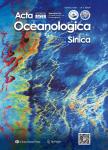Evaluation and projection of marine heatwaves in the South China Sea:insights from CMIP6 multi-model ensemble
作者机构:National Marine Environmental Forecasting Center State Key Laboratory of Tropical Oceanography South China Sea Institute of Oceanology Chinese Academy of Sciences State Key Laboratory of Severe Weather Chinese Academy of Meteorological Sciences National Meteorological CenterChina Meteorological Administration Inner Mongolia Autonomous Region Meteorological Observatory
出 版 物:《Acta Oceanologica Sinica》 (海洋学报(英文版))
年 卷 期:2024年第7期
页 面:15-25页
核心收录:
学科分类:07[理学] 070601[理学-气象学] 0706[理学-大气科学]
基 金:The National Natural Science Foundation of China under contract Nos 42275024 and 42105040 the Key R&D Program of China under contract No. 2022YFE0203500 the Guangdong Basic and Applied Basic Research Foundation under contract Nos2023B1515020009 and 2024B1515040024 the Youth Innovation Promotion Association CAS under contract No. 2020340 the Special Fund of South China Sea Institute of Oceanology of the Chinese Academy of Sciences under contract No. SCSIO2023QY01 the Science and Technology Planning Project of Guangzhou under contract No. 2024A04J6275
摘 要:This study evaluates the performance of 16 models sourced from the coupled model intercomparison project phase 6(CMIP6) in simulating marine heatwaves(MHWs) in the South China Sea(SCS) during the historical period(1982-2014), and also investigates future changes in SCS MHWs based on simulations from three shared socioeconomic pathway(SSP) scenarios(SSP126, SSP245, and SSP585) using CMIP6 models. Results demonstrate that the CMIP6 models perform well in simulating the spatial-temporal distribution and intensity of SCS MHWs,with their multi-model ensemble(MME) results showing the best performance. The reasonable agreement between the observations and CMIP6 MME reveals that the increasing trends of SCS MHWs are attributed to the warming sea surface temperature trend. Under various SSP scenarios, the year 2040 emerges as pivotal juncture for future shifts in SCS MHWs, marked by distinct variations in changing rate and amplitudes. This is characterized by an accelerated decrease in MHWs frequency and a notably heightened increase in mean intensity, duration, and total days after 2040. Furthermore, the projection results for SCS MHWs suggest that the spatial pattern of MHWs remains consistent across future periods. However, the intensity shows higher consistency only during the near-term period(2021-2050), while notable inconsistencies are observed during the medium-term(2041-2070) and long-term(2071-2100) periods under the three SSP scenarios. During the nearterm period, the SCS MHWs are characterized by moderate and strong events with high frequencies and relatively shorter durations. In contrast, during the medium-term period, MHWs are also characterized by moderate and strong events, but with longer-lasting and more intense events under the SSP245 and SSP585 scenarios. However,in the long-term period, extreme MHWs become the dominant feature under the SSP585 scenario, indicating a substantial intensification of SCS MHWs, effectively establishing a near-permanent state



